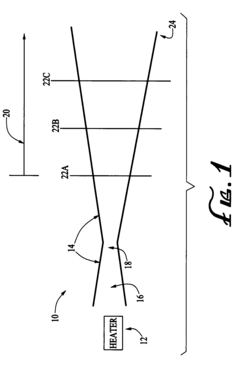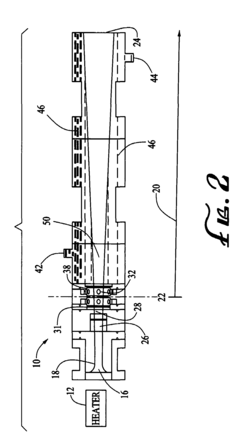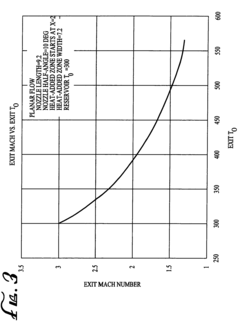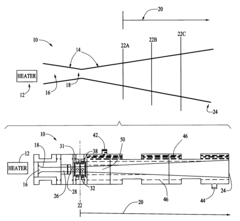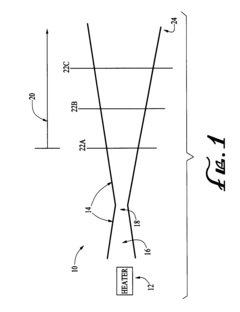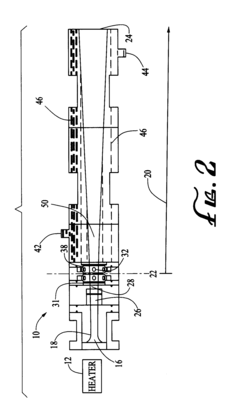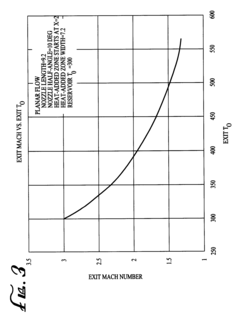Next-Gen Avionics for Scramjet-Powered Missile Systems
AUG 13, 20259 MIN READ
Generate Your Research Report Instantly with AI Agent
Patsnap Eureka helps you evaluate technical feasibility & market potential.
Scramjet Avionics Evolution and Objectives
Scramjet-powered missile systems have undergone significant evolution since their inception, driven by the need for hypersonic capabilities in modern warfare. The development of avionics for these systems has been a critical factor in their advancement. Initially, avionics for scramjet missiles were rudimentary, focusing primarily on basic flight control and propulsion management. As technology progressed, the complexity and capabilities of these systems expanded dramatically.
In the early stages, avionics were limited by the extreme conditions encountered during hypersonic flight, including intense heat and pressure. This led to the development of more robust and heat-resistant electronic components. The integration of advanced materials, such as ceramics and high-temperature alloys, became crucial in protecting sensitive avionics equipment.
As computational power increased, more sophisticated guidance and control systems were incorporated. These advancements allowed for improved trajectory optimization, enhancing the missile's range and accuracy. The introduction of adaptive flight control algorithms marked a significant milestone, enabling the missile to adjust its flight path in real-time based on changing atmospheric conditions and mission parameters.
Sensor technology has played a pivotal role in the evolution of scramjet avionics. Early systems relied on inertial navigation, which was prone to drift over long distances. The integration of GPS and other satellite-based navigation systems greatly improved positional accuracy. However, the vulnerability of these systems to jamming and spoofing led to the development of more robust, multi-modal navigation solutions.
The objectives for next-generation scramjet avionics are multifaceted and ambitious. One primary goal is to achieve greater autonomy, reducing reliance on external guidance and enhancing the missile's ability to operate in denied environments. This involves the development of advanced artificial intelligence and machine learning algorithms capable of making complex decisions in milliseconds.
Another key objective is the improvement of sensor fusion capabilities. By integrating data from multiple sensors, including radar, infrared, and electromagnetic sensors, future avionics systems aim to provide a more comprehensive situational awareness. This will enable more precise target acquisition and engagement, even in challenging operational scenarios.
Miniaturization and power efficiency are also critical objectives. As scramjet missiles push the boundaries of speed and range, every gram of weight and watt of power becomes crucial. Next-generation avionics must deliver increased performance while reducing size, weight, and power consumption.
In the early stages, avionics were limited by the extreme conditions encountered during hypersonic flight, including intense heat and pressure. This led to the development of more robust and heat-resistant electronic components. The integration of advanced materials, such as ceramics and high-temperature alloys, became crucial in protecting sensitive avionics equipment.
As computational power increased, more sophisticated guidance and control systems were incorporated. These advancements allowed for improved trajectory optimization, enhancing the missile's range and accuracy. The introduction of adaptive flight control algorithms marked a significant milestone, enabling the missile to adjust its flight path in real-time based on changing atmospheric conditions and mission parameters.
Sensor technology has played a pivotal role in the evolution of scramjet avionics. Early systems relied on inertial navigation, which was prone to drift over long distances. The integration of GPS and other satellite-based navigation systems greatly improved positional accuracy. However, the vulnerability of these systems to jamming and spoofing led to the development of more robust, multi-modal navigation solutions.
The objectives for next-generation scramjet avionics are multifaceted and ambitious. One primary goal is to achieve greater autonomy, reducing reliance on external guidance and enhancing the missile's ability to operate in denied environments. This involves the development of advanced artificial intelligence and machine learning algorithms capable of making complex decisions in milliseconds.
Another key objective is the improvement of sensor fusion capabilities. By integrating data from multiple sensors, including radar, infrared, and electromagnetic sensors, future avionics systems aim to provide a more comprehensive situational awareness. This will enable more precise target acquisition and engagement, even in challenging operational scenarios.
Miniaturization and power efficiency are also critical objectives. As scramjet missiles push the boundaries of speed and range, every gram of weight and watt of power becomes crucial. Next-generation avionics must deliver increased performance while reducing size, weight, and power consumption.
Market Analysis for Hypersonic Missile Systems
The global market for hypersonic missile systems has been experiencing significant growth and is projected to continue expanding in the coming years. This surge is primarily driven by increasing geopolitical tensions, the need for advanced defense capabilities, and ongoing technological advancements in the field of hypersonic propulsion and avionics.
Major defense contractors and aerospace companies are heavily investing in the development of hypersonic missile systems, recognizing their potential to revolutionize modern warfare. Countries such as the United States, Russia, China, and India are at the forefront of hypersonic technology development, allocating substantial resources to research and development programs.
The market for hypersonic missile systems can be segmented into two main categories: hypersonic glide vehicles (HGVs) and hypersonic cruise missiles (HCMs). HGVs are launched on ballistic missiles and glide to their targets at hypersonic speeds, while HCMs are powered throughout their flight by scramjet engines. Both types are gaining traction in military circles due to their ability to penetrate existing missile defense systems.
Key factors driving market growth include the increasing focus on modernizing military capabilities, the need for faster and more maneuverable weapon systems, and the potential for hypersonic missiles to serve as both conventional and nuclear delivery platforms. Additionally, the dual-use nature of hypersonic technology, with applications in both military and civilian sectors, is attracting investment from various industries.
The market for hypersonic missile systems is characterized by high barriers to entry due to the complex nature of the technology and the significant investment required for research and development. This has led to a concentrated market with a few dominant players, primarily large defense contractors and government-backed research institutions.
Despite the promising growth prospects, the market faces several challenges. These include the high costs associated with development and production, technical hurdles in materials science and propulsion technology, and concerns about the potential destabilizing effect of hypersonic weapons on global strategic balance.
Looking ahead, the market for hypersonic missile systems is expected to see continued growth as more countries seek to acquire these advanced capabilities. The integration of artificial intelligence and advanced sensors into hypersonic systems is likely to be a key trend, enhancing their precision and effectiveness. Furthermore, the development of counter-hypersonic technologies is emerging as a new segment within the market, driven by the need to defend against these advanced weapon systems.
Major defense contractors and aerospace companies are heavily investing in the development of hypersonic missile systems, recognizing their potential to revolutionize modern warfare. Countries such as the United States, Russia, China, and India are at the forefront of hypersonic technology development, allocating substantial resources to research and development programs.
The market for hypersonic missile systems can be segmented into two main categories: hypersonic glide vehicles (HGVs) and hypersonic cruise missiles (HCMs). HGVs are launched on ballistic missiles and glide to their targets at hypersonic speeds, while HCMs are powered throughout their flight by scramjet engines. Both types are gaining traction in military circles due to their ability to penetrate existing missile defense systems.
Key factors driving market growth include the increasing focus on modernizing military capabilities, the need for faster and more maneuverable weapon systems, and the potential for hypersonic missiles to serve as both conventional and nuclear delivery platforms. Additionally, the dual-use nature of hypersonic technology, with applications in both military and civilian sectors, is attracting investment from various industries.
The market for hypersonic missile systems is characterized by high barriers to entry due to the complex nature of the technology and the significant investment required for research and development. This has led to a concentrated market with a few dominant players, primarily large defense contractors and government-backed research institutions.
Despite the promising growth prospects, the market faces several challenges. These include the high costs associated with development and production, technical hurdles in materials science and propulsion technology, and concerns about the potential destabilizing effect of hypersonic weapons on global strategic balance.
Looking ahead, the market for hypersonic missile systems is expected to see continued growth as more countries seek to acquire these advanced capabilities. The integration of artificial intelligence and advanced sensors into hypersonic systems is likely to be a key trend, enhancing their precision and effectiveness. Furthermore, the development of counter-hypersonic technologies is emerging as a new segment within the market, driven by the need to defend against these advanced weapon systems.
Current Avionics Challenges in Scramjet Propulsion
The integration of scramjet propulsion into missile systems presents significant challenges for avionics, primarily due to the extreme operating conditions and unique flight characteristics associated with hypersonic flight. Current avionics systems face several critical hurdles in adapting to the demands of scramjet-powered missiles.
One of the primary challenges is the ability to withstand and operate in extreme temperature environments. Scramjet engines generate intense heat during operation, with temperatures potentially exceeding 2000°C. This thermal stress poses a significant threat to the integrity and functionality of electronic components within the avionics system. Conventional materials and cooling techniques used in subsonic and supersonic missile avionics are often inadequate for these extreme conditions.
Another major challenge lies in the development of robust and responsive control systems. Scramjet-powered missiles operate at hypersonic speeds, typically above Mach 5, which leaves minimal margin for error in flight control. The avionics must be capable of making split-second adjustments to maintain stability and trajectory in an environment where aerodynamic forces are highly complex and rapidly changing. This requires advanced sensors, high-speed data processing, and sophisticated control algorithms that can operate reliably under extreme g-forces and vibrations.
The harsh electromagnetic environment at hypersonic speeds also presents a significant challenge. Plasma formation around the vehicle can disrupt communication and navigation systems, potentially leading to loss of control or mission failure. Developing avionics that can maintain reliable communication and navigation capabilities in this environment is crucial for the success of scramjet-powered missile systems.
Fuel management and propulsion control represent another critical area of concern. Scramjet engines require precise control of airflow and fuel injection to maintain combustion at hypersonic speeds. The avionics system must accurately monitor and adjust these parameters in real-time, necessitating the development of advanced sensors and control systems that can operate effectively in high-temperature, high-pressure environments.
Weight and size constraints further complicate the development of next-generation avionics for scramjet-powered missiles. The need for thermal protection, radiation hardening, and robust components often conflicts with the requirement for compact, lightweight systems. Balancing these competing demands while ensuring system reliability and performance is a significant engineering challenge.
Lastly, the integration of various subsystems into a cohesive avionics package presents its own set of challenges. Ensuring seamless communication and coordination between propulsion control, flight management, navigation, and payload systems in a compact, high-stress environment requires innovative approaches to system architecture and integration.
One of the primary challenges is the ability to withstand and operate in extreme temperature environments. Scramjet engines generate intense heat during operation, with temperatures potentially exceeding 2000°C. This thermal stress poses a significant threat to the integrity and functionality of electronic components within the avionics system. Conventional materials and cooling techniques used in subsonic and supersonic missile avionics are often inadequate for these extreme conditions.
Another major challenge lies in the development of robust and responsive control systems. Scramjet-powered missiles operate at hypersonic speeds, typically above Mach 5, which leaves minimal margin for error in flight control. The avionics must be capable of making split-second adjustments to maintain stability and trajectory in an environment where aerodynamic forces are highly complex and rapidly changing. This requires advanced sensors, high-speed data processing, and sophisticated control algorithms that can operate reliably under extreme g-forces and vibrations.
The harsh electromagnetic environment at hypersonic speeds also presents a significant challenge. Plasma formation around the vehicle can disrupt communication and navigation systems, potentially leading to loss of control or mission failure. Developing avionics that can maintain reliable communication and navigation capabilities in this environment is crucial for the success of scramjet-powered missile systems.
Fuel management and propulsion control represent another critical area of concern. Scramjet engines require precise control of airflow and fuel injection to maintain combustion at hypersonic speeds. The avionics system must accurately monitor and adjust these parameters in real-time, necessitating the development of advanced sensors and control systems that can operate effectively in high-temperature, high-pressure environments.
Weight and size constraints further complicate the development of next-generation avionics for scramjet-powered missiles. The need for thermal protection, radiation hardening, and robust components often conflicts with the requirement for compact, lightweight systems. Balancing these competing demands while ensuring system reliability and performance is a significant engineering challenge.
Lastly, the integration of various subsystems into a cohesive avionics package presents its own set of challenges. Ensuring seamless communication and coordination between propulsion control, flight management, navigation, and payload systems in a compact, high-stress environment requires innovative approaches to system architecture and integration.
Existing Avionics Solutions for Scramjet Missiles
01 Advanced Flight Control Systems
Next-generation avionics incorporate sophisticated flight control systems that enhance aircraft performance, stability, and safety. These systems utilize advanced sensors, algorithms, and actuators to provide precise control over various flight parameters, enabling improved maneuverability and automated flight operations.- Advanced Flight Control Systems: Next-generation avionics incorporate sophisticated flight control systems that enhance aircraft performance, stability, and safety. These systems utilize advanced sensors, algorithms, and actuators to provide precise control over various flight parameters, enabling improved maneuverability and automated flight operations.
- Integrated Cockpit Displays: Modern avionics feature integrated cockpit displays that consolidate multiple information sources into user-friendly interfaces. These displays provide pilots with comprehensive situational awareness, including flight data, navigation information, and system status, enhancing decision-making and reducing workload.
- Enhanced Communication and Connectivity: Next-gen avionics systems incorporate advanced communication technologies, enabling seamless connectivity between aircraft, ground stations, and satellites. These systems facilitate real-time data exchange, improve air traffic management, and enhance overall operational efficiency and safety.
- Artificial Intelligence and Machine Learning Integration: Avionics systems are increasingly incorporating AI and machine learning capabilities to enhance decision-making, predictive maintenance, and autonomous operations. These technologies enable adaptive flight planning, optimized fuel consumption, and improved fault detection and diagnosis.
- Enhanced Navigation and Positioning Systems: Next-generation avionics feature advanced navigation and positioning systems that utilize multiple data sources, including GPS, inertial navigation, and terrain mapping. These systems provide highly accurate and reliable position information, enabling precise navigation in various environmental conditions and supporting advanced flight operations.
02 Integrated Cockpit Displays
Modern avionics feature integrated cockpit displays that consolidate multiple information sources into user-friendly interfaces. These displays provide pilots with comprehensive situational awareness, including flight data, navigation information, and system status, enhancing decision-making and reducing workload.Expand Specific Solutions03 Enhanced Communication and Connectivity
Next-gen avionics systems incorporate advanced communication technologies to improve connectivity between aircraft, ground stations, and satellites. These systems enable real-time data exchange, enhancing navigation accuracy, weather awareness, and overall operational efficiency.Expand Specific Solutions04 Artificial Intelligence and Machine Learning Integration
Avionics systems are increasingly incorporating artificial intelligence and machine learning algorithms to enhance decision-making processes, predictive maintenance, and autonomous operations. These technologies enable more efficient flight planning, real-time system optimization, and improved fault detection and diagnosis.Expand Specific Solutions05 Advanced Sensor Fusion and Data Processing
Next-generation avionics utilize advanced sensor fusion techniques and data processing capabilities to integrate information from multiple sources. This approach enhances situational awareness, improves navigation accuracy, and enables more precise aircraft control in various environmental conditions.Expand Specific Solutions
Key Players in Scramjet Avionics Development
The research on next-generation avionics for scramjet-powered missile systems is in a nascent stage, characterized by intense competition and rapid technological advancements. The market is relatively small but growing, driven by increasing defense budgets and the need for hypersonic capabilities. Key players include established aerospace giants like Lockheed Martin, Raytheon, and Northrop Grumman, alongside specialized research institutions such as the Naval Research Laboratory and Chinese universities like NUDT and NUAA. The technology is still in early development, with most companies focusing on R&D and prototype testing rather than full-scale production. Collaboration between academic institutions and industry leaders is crucial for overcoming technical challenges and accelerating progress in this cutting-edge field.
Raytheon Co.
Technical Solution: Raytheon's approach to next-generation avionics for scramjet-powered missile systems focuses on advanced thermal management and integrated sensor fusion. They have developed a novel cooling system that utilizes endothermic fuel as a heat sink, allowing for efficient thermal regulation in hypersonic environments[1]. This is coupled with a state-of-the-art avionics suite that incorporates AI-driven sensor fusion, enabling real-time trajectory optimization and threat assessment[3]. Raytheon's system also features advanced materials for radome and antenna design, capable of withstanding extreme temperatures while maintaining communication integrity[5].
Strengths: Cutting-edge thermal management, AI-enhanced sensor fusion, and advanced materials. Weaknesses: High development costs and potential integration challenges with existing systems.
Lockheed Martin Corp.
Technical Solution: Lockheed Martin's research on next-gen avionics for scramjet-powered missiles centers on a modular, open-architecture approach. Their system, known as the Hypersonic Avionics Integration Platform (HAIP), allows for rapid integration of new technologies and easy upgrades[2]. HAIP incorporates advanced inertial measurement units (IMUs) and GPS-denied navigation capabilities, crucial for operating in contested environments[4]. Lockheed has also developed a novel cooling system using a combination of regenerative cooling and ablative materials, addressing the extreme heat generated during hypersonic flight[6]. Additionally, their avionics package includes advanced electronic warfare capabilities to enhance survivability[8].
Strengths: Modular design for easy upgrades, advanced navigation in GPS-denied environments, and integrated electronic warfare capabilities. Weaknesses: Potential complexity in system integration and high initial development costs.
Core Innovations in Scramjet Control Systems
Method for using variable supersonic Mach number air heater utilizing supersonic combustion
PatentInactiveUS7296396B1
Innovation
- A supersonic combustion heater apparatus that varies exit plane Mach numbers through strategic fuel injection and flame stabilization in a fixed geometry nozzle, enhancing high enthalpy flow and flame stability without using expensive film cooled nozzles, allowing for mode transition testing in air-breathing propulsion systems.
Variable supersonic mach number air heater utilizing supersonic combustion
PatentInactiveUS8087229B2
Innovation
- A supersonic combustion heater with strategically positioned fuel injection means and flame stabilization techniques that vary Mach numbers at the exit plane by heat addition in the diverging area, enhancing enthalpy flow, flame stability, and mixing without the need for expensive film-cooled nozzles, using a fixed geometric nozzle with converging and diverging areas and incorporating oxygen injection for stability.
Materials Science Advancements for Hypersonic Flight
The development of next-generation avionics for scramjet-powered missile systems heavily relies on advancements in materials science for hypersonic flight. These advancements are crucial to overcome the extreme conditions encountered during hypersonic travel, including high temperatures, intense aerodynamic loads, and severe thermal stresses.
One of the primary focuses in materials science for hypersonic flight is the development of ultra-high temperature ceramics (UHTCs). These materials, such as zirconium diboride and hafnium carbide, exhibit exceptional thermal stability and oxidation resistance at temperatures exceeding 2000°C. Recent research has shown promising results in enhancing the fracture toughness of UHTCs through the incorporation of carbon nanotubes and graphene, addressing their inherent brittleness.
Thermal protection systems (TPS) are another critical area of materials science advancement. Novel ablative materials, including carbon-phenolic composites and AVCOAT, have been engineered to withstand the extreme heat generated during hypersonic flight. These materials undergo controlled decomposition, absorbing and dissipating heat to protect the underlying structure.
Advancements in ceramic matrix composites (CMCs) have led to the development of materials that combine high-temperature capabilities with improved mechanical properties. Silicon carbide-based CMCs, reinforced with carbon fibers, offer excellent thermal shock resistance and creep performance, making them ideal for engine components and leading edges of hypersonic vehicles.
Nanostructured materials have emerged as a promising avenue for hypersonic applications. Researchers have developed nanocomposites that exhibit enhanced thermal conductivity and reduced thermal expansion, crucial for maintaining structural integrity under extreme temperature gradients. These materials often incorporate nanoparticles or nanotubes to tailor their properties for specific hypersonic flight requirements.
Coatings and surface treatments have also seen significant advancements. Environmental barrier coatings (EBCs) based on rare-earth silicates have demonstrated superior resistance to water vapor attack and thermal cycling. Additionally, self-healing materials that can repair microcracks during flight are being explored to enhance the longevity and reliability of hypersonic structures.
The integration of smart materials and structures into hypersonic vehicles is an emerging trend. Shape memory alloys and piezoelectric materials are being investigated for their potential in active flow control and structural health monitoring, enabling real-time adaptation to changing flight conditions.
One of the primary focuses in materials science for hypersonic flight is the development of ultra-high temperature ceramics (UHTCs). These materials, such as zirconium diboride and hafnium carbide, exhibit exceptional thermal stability and oxidation resistance at temperatures exceeding 2000°C. Recent research has shown promising results in enhancing the fracture toughness of UHTCs through the incorporation of carbon nanotubes and graphene, addressing their inherent brittleness.
Thermal protection systems (TPS) are another critical area of materials science advancement. Novel ablative materials, including carbon-phenolic composites and AVCOAT, have been engineered to withstand the extreme heat generated during hypersonic flight. These materials undergo controlled decomposition, absorbing and dissipating heat to protect the underlying structure.
Advancements in ceramic matrix composites (CMCs) have led to the development of materials that combine high-temperature capabilities with improved mechanical properties. Silicon carbide-based CMCs, reinforced with carbon fibers, offer excellent thermal shock resistance and creep performance, making them ideal for engine components and leading edges of hypersonic vehicles.
Nanostructured materials have emerged as a promising avenue for hypersonic applications. Researchers have developed nanocomposites that exhibit enhanced thermal conductivity and reduced thermal expansion, crucial for maintaining structural integrity under extreme temperature gradients. These materials often incorporate nanoparticles or nanotubes to tailor their properties for specific hypersonic flight requirements.
Coatings and surface treatments have also seen significant advancements. Environmental barrier coatings (EBCs) based on rare-earth silicates have demonstrated superior resistance to water vapor attack and thermal cycling. Additionally, self-healing materials that can repair microcracks during flight are being explored to enhance the longevity and reliability of hypersonic structures.
The integration of smart materials and structures into hypersonic vehicles is an emerging trend. Shape memory alloys and piezoelectric materials are being investigated for their potential in active flow control and structural health monitoring, enabling real-time adaptation to changing flight conditions.
International Regulations on Hypersonic Weapons
The development and deployment of hypersonic weapons have raised significant concerns in the international community, prompting the establishment of various regulations and agreements. The Missile Technology Control Regime (MTCR), established in 1987, plays a crucial role in limiting the proliferation of missile technology capable of delivering weapons of mass destruction. While not specifically targeting hypersonic weapons, the MTCR's guidelines apply to systems that can deliver a payload of at least 500 kg to a range of at least 300 km, which encompasses many hypersonic weapon designs.
The United Nations has also addressed the issue of hypersonic weapons through its disarmament efforts. The UN Office for Disarmament Affairs has highlighted the potential destabilizing effects of these weapons and called for increased transparency and dialogue among nations. Additionally, the UN General Assembly has passed resolutions urging member states to exercise restraint in the development and testing of hypersonic weapon systems.
Bilateral agreements between major powers have also emerged as a means of regulating hypersonic weapons. The New START Treaty between the United States and Russia, while primarily focused on strategic nuclear weapons, includes provisions that could potentially apply to certain types of hypersonic delivery systems. However, the treaty's applicability to newer hypersonic technologies remains a subject of debate and negotiation.
Regional organizations have also taken steps to address the challenges posed by hypersonic weapons. The European Union, for instance, has expressed concerns about the potential impact of these weapons on strategic stability and has called for the development of international norms and confidence-building measures. Similarly, the Association of Southeast Asian Nations (ASEAN) has emphasized the importance of maintaining regional peace and stability in light of emerging hypersonic capabilities.
Despite these efforts, the regulation of hypersonic weapons faces significant challenges. The dual-use nature of many hypersonic technologies, which have both civilian and military applications, complicates efforts to establish clear-cut restrictions. Furthermore, the rapid pace of technological advancement often outstrips the ability of international regulatory frameworks to adapt, creating potential loopholes and areas of ambiguity.
As research on next-generation avionics for scramjet-powered missile systems progresses, it is crucial for developers and policymakers to remain cognizant of the evolving international regulatory landscape. Compliance with existing agreements and participation in ongoing diplomatic efforts to establish new norms will be essential for ensuring that technological advancements in this field do not undermine global security and stability.
The United Nations has also addressed the issue of hypersonic weapons through its disarmament efforts. The UN Office for Disarmament Affairs has highlighted the potential destabilizing effects of these weapons and called for increased transparency and dialogue among nations. Additionally, the UN General Assembly has passed resolutions urging member states to exercise restraint in the development and testing of hypersonic weapon systems.
Bilateral agreements between major powers have also emerged as a means of regulating hypersonic weapons. The New START Treaty between the United States and Russia, while primarily focused on strategic nuclear weapons, includes provisions that could potentially apply to certain types of hypersonic delivery systems. However, the treaty's applicability to newer hypersonic technologies remains a subject of debate and negotiation.
Regional organizations have also taken steps to address the challenges posed by hypersonic weapons. The European Union, for instance, has expressed concerns about the potential impact of these weapons on strategic stability and has called for the development of international norms and confidence-building measures. Similarly, the Association of Southeast Asian Nations (ASEAN) has emphasized the importance of maintaining regional peace and stability in light of emerging hypersonic capabilities.
Despite these efforts, the regulation of hypersonic weapons faces significant challenges. The dual-use nature of many hypersonic technologies, which have both civilian and military applications, complicates efforts to establish clear-cut restrictions. Furthermore, the rapid pace of technological advancement often outstrips the ability of international regulatory frameworks to adapt, creating potential loopholes and areas of ambiguity.
As research on next-generation avionics for scramjet-powered missile systems progresses, it is crucial for developers and policymakers to remain cognizant of the evolving international regulatory landscape. Compliance with existing agreements and participation in ongoing diplomatic efforts to establish new norms will be essential for ensuring that technological advancements in this field do not undermine global security and stability.
Unlock deeper insights with Patsnap Eureka Quick Research — get a full tech report to explore trends and direct your research. Try now!
Generate Your Research Report Instantly with AI Agent
Supercharge your innovation with Patsnap Eureka AI Agent Platform!

